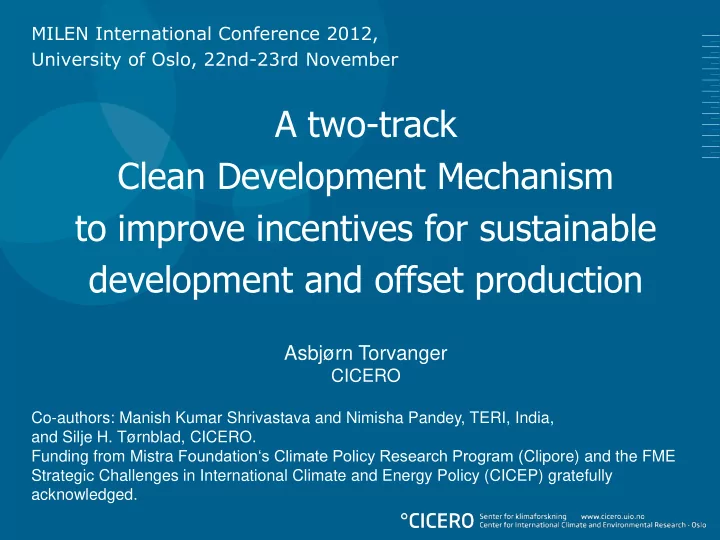

MILEN International Conference 2012, University of Oslo, 22nd-23rd November A two-track Clean Development Mechanism to improve incentives for sustainable development and offset production Asbjørn Torvanger CICERO Co-authors: Manish Kumar Shrivastava and Nimisha Pandey, TERI, India, and Silje H. Tørnblad, CICERO. Funding from Mistra Foundation‘s Climate Policy Research Program ( Clipore) and the FME Strategic Challenges in International Climate and Energy Policy (CICEP) gratefully acknowledged.
Topics A CDM brief CDM objectives Performance Reform Our proposal: A two-track CDM mechanism
A CDM brief • One of three flexibility mechanisms under the Kyoto Protocol • Baseline and credit based; host is developing country • Strong growth in volume since start in 2005 • CDM is the most important carbon offset mechanism in the world • Concentrated host countries • Concentrated buyer countries (mostly EU countries) • Private sector dominates • Uncertain future: small demand - low price
A CDM project Reference emission path CO 2 emissions Emissions after CDM project realized Start time End time Time
Distribution of CDM projects
CDM and EU ETS compared
Two primary CDM objectives The Kyoto Protocol (KP): Assist DCs in achieving SD Assist ICs in meeting targets under KP (offsets) Design of CDM reflects priority to offset production. Additional: • Funding of adaptation actions in DCs (fee) • Capacity building in DCs: climate policy; energy policies; business thinking • Technology transfer • Global climate collaboration; trust building
Why CDM reform? Environmental integrity (offset) performance insufficient Sustainable development performance insufficient • CDM too bureaucratic with high transaction costs • Skewed geographical distribution of projects • Too many projects with industry gases • New, upcoming climate policy treaty
CDM performance: SD No common accepted interpretation of SD. SD criteria and assessment of a project decided by host country. Most frequent criterion: * Technology transfer and diffusion. Findings: only successful to limited extent Other aspects: Employment creation; social aspects; environmental aspects. Findings: only marginal SD benefits.
CDM performance: Offsets Environmental additionality in real terms? Studies: Cannot be sure of this since baseline is uncertain and contra factual. Incentives to exaggerate effect on emissions. May lead to increased global emissions. Economic additionality Is the project profitable without CDM funding? Studies: Difficult and questionable
What is the real emission reduction? Reference emission path CO 2 emissions “True” reference path Emissions after CDM project realized Start time End time Time
Proposals to improve the CDM: SD Output based: • Measurable SD criteria; general or at national level • Stricter SD criteria • Emphasize capacity building in DCs Input based: • Project category • Resources spent on project • Fixed fee on CDM transactions to finance SD
Proposals to improve the CDM: Offset production Stricter rules for acceptance Stricter eligibility requirements (project type; technologies)(positive list; negative list) Benchmarking (specific for each industry) Discount CERs to compensate for risk of not satisfying additionality Limit offset use; more ambitious target Streamlining - Aggregation of CDM projects: sector based; programmatic; policy CDM Simplify CDM administration
The challenge of combining SD and offset production • Better SD performance would imply higher cost of CERs and thus lower volume. SD benefits not linked to pricing of CERs. • CDM primarily designed for OP - weak framework for SD. Could be ’race to bottom’ to ease offset production and lower production cost. • Empirical evidence show either high rating for OP or for SD contribution
A two-track mechanism Our idea is to split CDM into two tracks: 1. OP track with strict demands on measurability, reportability, verifiability. 2. SD track with focus on SD performance. • International community agree on a) Certain percentage of purchased CERs must be from SD track. b) Definition of SD and criteria for SD and requirements for measurement, reporting, and verification • Will induce higher price for CERs with SD benefits. • Alternative: Funding of SD projects in DCs accepted as part of meeting national climate commitment by IC
Summary Present CDM design has weaknesses w.r.t. real GHG reductions and supporting SD in host DCs. May undermine CDM credibility. Yet CDM has had sizeable impact on DC capacity building. Challenges fulfilling SD and offset requirements in same project. A possible solution is decoupling, spitting CDM into one track for offset production and one track for SD Can imply that only some project types are eligible for legitimate CER production.
Recommend
More recommend